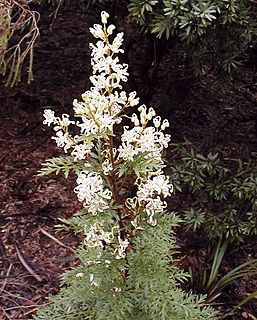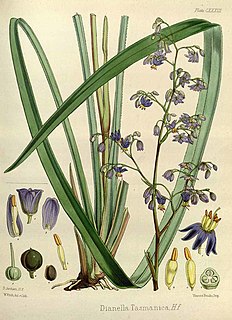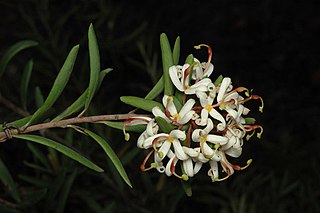
Lomatia tasmanica, commonly known as King's lomatia, is a shrub of the family Proteaceae native to Tasmania. Growing up to 8 metres (26 ft) tall, the plant has shiny green pinnate (lobed) leaves and bears red flowers in the summer, but yields neither fruit nor seeds. King's lomatia is unusual because all of the remaining plants are genetically identical clones. Because it has three sets of chromosomes and is therefore sterile, reproduction occurs only vegetatively: when a branch falls, that branch grows new roots, establishing a new plant that is genetically identical to its parent.

Lomatia is a genus of 12 species of evergreen flowering plants in the protea family Proteaceae. Within the family, they have been placed, alone, in their own subtribe, Lomatiinae according to Johnson & Briggs 1975 classification of the family and subsequently in Flora of Australia (1995).

Spergularia is a genus in the family Caryophyllaceae, containing salt-tolerant plants known as sandspurrys and sea-spurreys. There are about 60 species.

Dianella tasmanica, commonly known as the Tasman flax-lily or Tasmanian flax-lily is a herbaceous strappy perennial herb of the family Asphodelaceae, subfamily Hemerocallidoideae, found in southeastern Australia including Tasmania. It has leaves to 80 cm, and a flower stem to 1.5 m. Blue flowers in spring and summer are followed by violet berries. It adapts readily to cultivation and is commonly seen in Australian gardens. Unlike other Dianella species, its fruit is toxic.
This is a list of the terrestrial flora of the Houtman Abrolhos. Only vascular plants are listed — there have been some collections of mosses, liverworts and lichens from the Houtman Abrolhos, but no information has been published on these non-vascular groups.

Isophysis is a genus of herbaceous, perennial and rhizomatous plants in the Iris family (Iridaceae). A monotypic genus formerly known as Hewardia, it contains a single species, Isophysis tasmanica, endemic to the mountains of Western Tasmania growing in heathland on sandy soils. It has grass-like foliage and star-like dark red-purple or yellow flowers with reflexed tepals. A characteristic feature of this species is its superior ovary, which distinguishes it from any other member of Iridaceae. The genus name is derived from the Greek words iso, meaning "equal", and physis, meaning "bladder".

Liotia is a genus of very small sea snails, marine gastropod mollusks in the family Liotiidae.
Zeidora is a genus of sea snails, marine gastropod mollusks in the family Fissurellidae, the keyhole limpets.

Munditia is a genus of sea snails, marine gastropod mollusks in the family Liotiidae.

Liotina is a genus of sea snails, marine gastropod mollusks in the family Liotiidae.

Austromitra is a genus of sea snails, marine gastropod mollusks in the family Costellariidae.

Gazameda is a genus of sea snails, marine gastropod mollusks in the family Turritellidae.

The Tasmanian darner,, is a species of large dragonfly in the family Telephlebiidae, which includes some of the world's largest dragonflies. It is found in Tasmania, Australia. The species was first described by Robert Tillyard in 1916 and inhabits streams and rivers.

Spergularia media is a species of flowering plant in the family Caryophyllaceae known by the common names media sandspurry and greater sea-spurrey. It is native to Eurasia and the Mediterranean, where it grows in many types of habitat, including disturbed areas, including places with saline substrates, such as salt marshes and beaches. It is known in many other parts of the world as an introduced species and a common roadside weed. In North America it is a "highway halophyte", often springing up at the margins of roads that are heavily salted in the winter.
Zeidora tasmanica is a species of sea snail, a marine gastropod mollusk in the family Fissurellidae, the keyhole limpets and slit limpets.
Zostera tasmanica is a species of marine eelgrass in the Zosteraceae family. It is native to the seacoasts of Tasmania, New South Wales, Victoria, South Australia, and Western Australia.

Lomatia polymorpha, commonly known as mountain guitar plant, is a shrub or small tree of the family Proteaceae which is endemic to Tasmania. It is a shrub or small tree with linear leaves, and white, cream-coloured or greenish flowers. It is common throughout its range which is approximately complementary to that of L. tinctoria in Tasmania.

Spergularia marina, also called Spergularia salina, is a species of flowering plant in the family Caryophyllaceae. It is known as salt sandspurry or lesser sea-spurrey. S. marina is a sprawling annual or sometimes perennial, with stems up to 35 cm (14 in) long. Like other sea-spurrey species, its flowers have white to pink petals, with sepals usually longer than the petals, at 2.5–4 mm (0.1–0.2 in). Plants are salt-tolerant, being found by the sea and in saline areas inland.

Synthemis tasmanica is a species of dragonfly in the family Synthemistidae, known as the Tasmanian swamp tigertail. It is found in Tasmania, Australia, where it inhabits seepages and bogs. It is a slender, medium-sized dragonfly with black and yellow markings.
Myrabolia is the only genus in the beetle family Myraboliidae. It has about 13 species, found in Australia.















